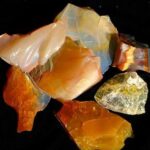When it comes to variety of color and eye-catching brilliance, opals are hard to beat. Before you start shopping for opal jewelry, though, learn a little about how to determine the value of an opal so you’ll be able to find the highest quality that fits your budget.
When choosing an opal, the most important factors to consider are the gemstone’s type, size, color and brilliance. Unless you have a flexible budget, you’ll probably have to make some trade offs, but in general you should be able to find a beautiful opal even on a modest budget.
Type
Opals are typed by their background color (also known as “body tone”). The three main types of opal are black, crystal, and white/milk. The rarity of the color is what determines its market value. The rarest and highest priced per carat weigh is black opal, which has a dark background. There are also gray and semi-black opals, but they’re considered less valuable.
The next up is crystal opal, a transparent stone that reflects color beautifully. After that comes the relatively common white/milk opal. Other type of opal include boulder opal and matrix opal. You may also hear the terms solid, inlay, doublet and triplet opals, but these refer to how the opals are used in jewelry, rather than to the gemstones themselves.
Size
Really this one goes without staying, but assuming all else is equal, the bigger the opal, the more valuable it is. As with other gemstones, like diamonds and rubies, opals are measured by their weight in carats.
Play of color
The opal’s iridescence is the most attractive thing about this gemstone, so naturally how the interplay of colors is important. The most valuable opals will have a vibrant play of color without any “dead” or white spots. Exactly which colors the opal reflects also affects its value. The most highly prized colors are, in order, red, orange yellow, green, and blue. The more colors a gemstone includes, the more valuable it is. Keep in mind, though, this has to do more with rarity than with quality. Color makes no difference in how “perfect” the opal is or how long it will last.
Brilliance
In addition to color, how much light an opal reflects plays a vital role in determining its value. The most valuable opals sparkle with bright flashes of color, whereas opals with dull colors are less valuable. In fact, some cheaper white opals may have no noticeable color flashes at all. Even if a stone has a nice range of colors, if they’re dull, the value of the gemstone won’t be as great. A stone with only one color, but one that flashes brightly, will surpass it in value. After all, what good is color if you need a magnifying glass to see it?
Pattern
Occasionally, color occurs in opals in a distinct patterns that opal connoisseurs have given descriptive names like peacock tail, jigsaw, Chinese writing, and moss. While all patterns add value to an opal, broad patches of color are more valuable than smaller, pinfire patterns. It may be temping to search for an opal with one of these specific patterns, but keep in mind that patterns like these are quite rare and thus expensive. Some, like the harlequin and peacock tail, require quite an investment to buy. On the positive side, every opal has its own unique pattern that can be just as beautiful.
Faults
Understandably, the more perfectly formed an opal gemstone is, the more valuable it is. Opals are less valuable when marred by inclusions (other minerals inside the opal) and have almost no value if crazing (small fractures) is apparent. This isn’t just for aesthetic reasons; crazing in an opal makes it more likely to develop large cracks in heat or dry conditions.
As with any jewelry, the ultimate value of opal jewelry is in how attractive the piece is to you personally. If you find crystal opal more appealing than black opal, or prefer blue to red, there’s no reason you shouldn’t buy that type of opal. Just know that you shouldn’t have to pay the same price for it as for what jewelers consider “top quality.”




